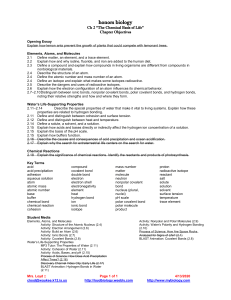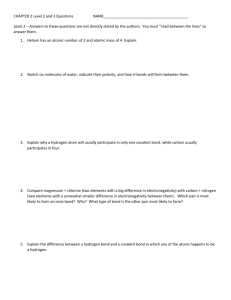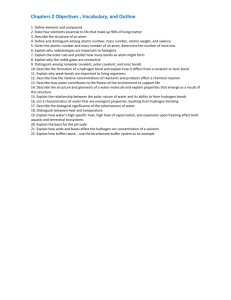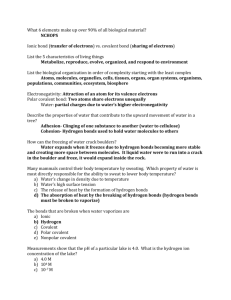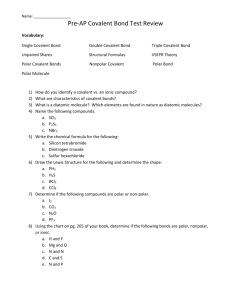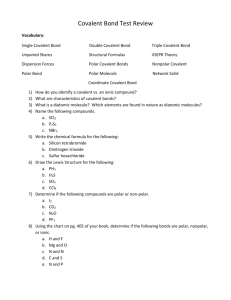CH 2 objectives--The Chemical Basis of Life
advertisement
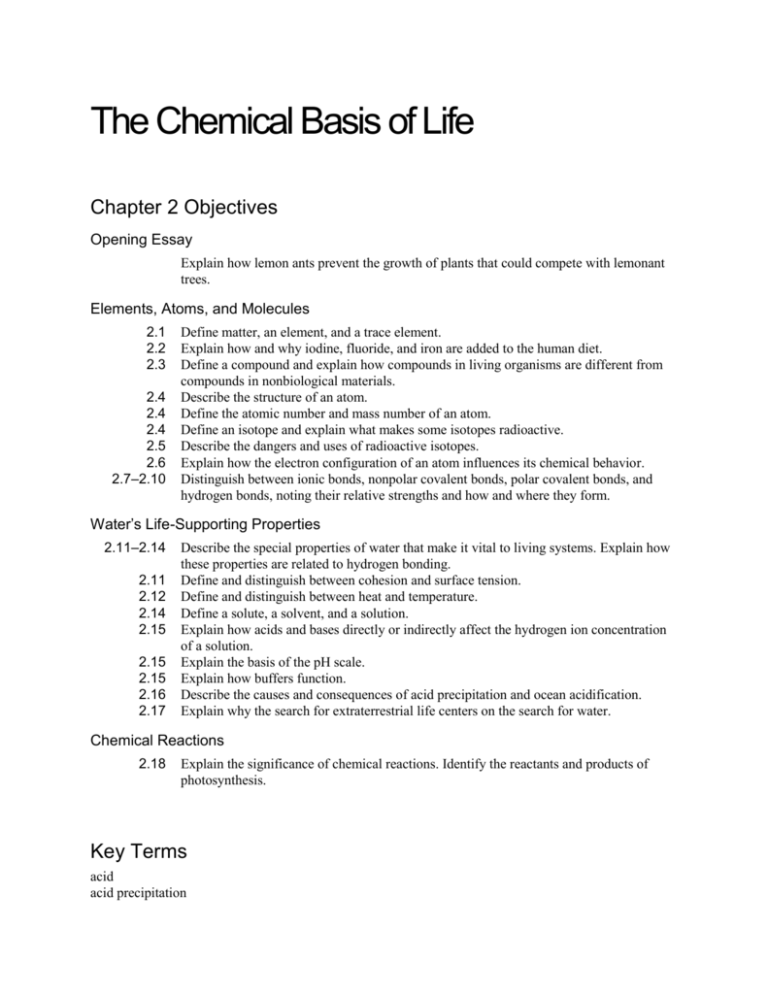
The Chemical Basis of Life Chapter 2 Objectives Opening Essay Explain how lemon ants prevent the growth of plants that could compete with lemonant trees. Elements, Atoms, and Molecules 2.1 2.2 2.3 2.4 2.4 2.4 2.5 2.6 2.7–2.10 Define matter, an element, and a trace element. Explain how and why iodine, fluoride, and iron are added to the human diet. Define a compound and explain how compounds in living organisms are different from compounds in nonbiological materials. Describe the structure of an atom. Define the atomic number and mass number of an atom. Define an isotope and explain what makes some isotopes radioactive. Describe the dangers and uses of radioactive isotopes. Explain how the electron configuration of an atom influences its chemical behavior. Distinguish between ionic bonds, nonpolar covalent bonds, polar covalent bonds, and hydrogen bonds, noting their relative strengths and how and where they form. Water’s Life-Supporting Properties 2.11–2.14 2.11 2.12 2.14 2.15 2.15 2.15 2.16 2.17 Describe the special properties of water that make it vital to living systems. Explain how these properties are related to hydrogen bonding. Define and distinguish between cohesion and surface tension. Define and distinguish between heat and temperature. Define a solute, a solvent, and a solution. Explain how acids and bases directly or indirectly affect the hydrogen ion concentration of a solution. Explain the basis of the pH scale. Explain how buffers function. Describe the causes and consequences of acid precipitation and ocean acidification. Explain why the search for extraterrestrial life centers on the search for water. Chemical Reactions 2.18 Explain the significance of chemical reactions. Identify the reactants and products of photosynthesis. Key Terms acid acid precipitation adhesion aqueous solution atom atomic mass atomic number base buffer chemical bond chemical reaction cohesion compound covalent bond double bond electron electron shell electronegativity element heat hydrogen bond ion ionic bond isotope mass number matter molecule neutron nonpolar covalent bond nucleus (plural, nuclei) pH scale polar covalent bond polar molecule product proton radioactive isotope reactant salt solute solution solvent surface tension temperature trace element Word Roots an- 5 not (anion: a negatively charged ion) aqua- 5 water (aqueous solution: a solution in which water is the solvent) co- 5 together; -valent 5 strength (covalent bond: an attraction between atoms that share one or more pairs of outer-shell electrons) electro- 5 electricity (electronegativity: the attraction of a given atom for the electrons of a covalent bond) iso- 5 equal (isotope: a variant form of an atomic element having the same number of protons and electrons but a different number of neutrons) neutr- 5 neither (neutron: a subatomic particle no electrical charge) pro- 5 before (proton: a subatomic particle with a single positive electrical charge) Student Media Elements, Atoms, and Molecules Activity: Structure of the Atomic Nucleus (2.4) Activity: Electron Arrangement (2.6) Activity: Build an Atom (2.6) Activity: Ionic Bonds (2.7) Activity: Covalent Bonds (2.8) Activity: Nonpolar and Polar Molecules (2.9) Activity: Water’s Polarity and Hydrogen Bonding (2.10) Process of Science: How Are Space Rocks Analyzed for Signs of Life? (2.1) BLAST Animation: Covalent Bonds (2.8) Water’s Life-Supporting Properties MP3 Tutor: The Properties of Water (2.11) Activity: Cohesion of Water (2.11) Activity: Acids, Bases, and pH (2.15) Process of Science: How Does Acid Precipitation Affect Trees? (2.16) Discovery Channel Video Clip: Early Life (2.17) BLAST Animation: Hydrogen Bonds in Water (2.11) Chemical Reactions
